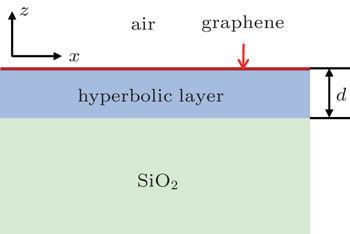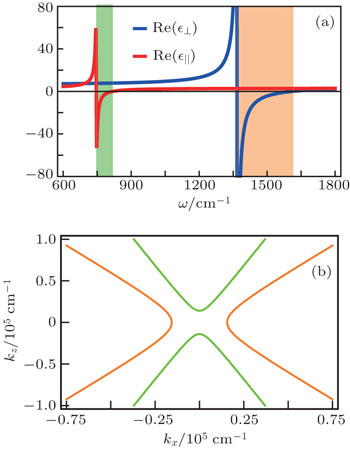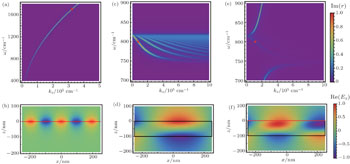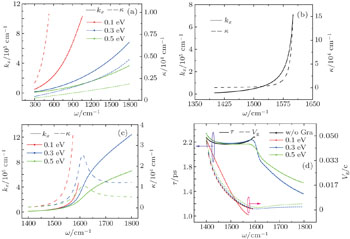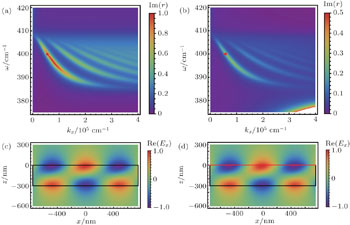† Corresponding author. E-mail:
Project supported by the National Natural Science Foundation of China (Grant No. 61271085) and the Natural Science Foundation of Zhejiang Province, China (Grant No. LR15F050001).
Polar dielectrics are important optical materials enabling the subwavelength manipulation of light in infrared due to their capability to excite phonon polaritons. In practice, it is highly desired to actively modify these hyperbolic phonon polaritons (HPPs) to optimize or tune the response of the device. In this work, we investigate the plasmonic material, a monolayer graphene, and study its hybrid structure with three kinds of hyperbolic thin films grown on SiO2 substrate. The inter-mode hybridization and their tunability have been thoroughly clarified from both the band dispersions and the mode patterns numerically calculated through a transfer matrix method. Our results show that these hybrid multilayer structures are of strong potentials for applications in plasmonic waveguides, modulators and detectors in infrared.
Polar dielectric crystals can show hyperbolic dispersion characters in infrared arising from their ionic resonance driven by external electromagnetic (EM) fields, such as having anisotropic dielectric constants with sign difference.[1] On their surfaces with air, bounded phonon polaritons could be excited in the resonance state. Like hyperbolic metamaterials, light with large wavevectors or high energy density state can propagate inside these kinds of natural indefinite anisotropic materials.[2,3] Many interesting phenomena and related technological applications can be inspired by these special materials as subwavelength imaging,[4] sensing engineering,[5] or enhanced light radiation.[6] However, like plasmonic behaviors of noble metals in the visible regime,[7,8] it is hard to actively control or modify the EM properties of a hyperbolic dielectric once the device is fabricated. In practice, activity or tunable function is often desired in order to optimize or modulate the device performance, particularly when considering the narrow band phonon resonance nature of polar dielectrics. For this aim conductive materials with variable charge densities through optical pumping or electric doping have been adopted in the design of reconfigurable plasmonic devices.[9] Among them, graphene due to the relatively low damping loss and wideband response has attracted great attention as a key variable component, especially in the heterostructures of graphene–hexagonal boron nitride (hBN) composite in recent years.[10,11] Electron oscillations in graphene and ionic vibrations in polar dielectrics can produce plasmon–phonon hybrid modes. This hybrid structure, regarded as an advanced version of two-dimensional (2D) metamaterials, can absorb the virtues of both the hyperbolic dielectric and graphene by offering more freedoms to manipulate infrared waves and thus create new functional optical devices.[12–14] It has been pointed out that graphene on a plasmonic dielectric substrate will possess larger carrier mobility than on a normal insulator such as SiO2.[15] In principle, reconfigurable plasmonic devices or functionalities in infrared can be anticipated applying this hybrid structure plus the additional features of low-loss and wideband.
In this work, we systematically investigated three kinds of graphene–hyperbolic heterostructures including graphene–hBN, graphene–aluminum nitride (AlN) and graphene–zinc oxide (ZnO), which all show strong electron–phonon coupling resonance in the mid-infrared regime. Among these hyperbolic components, hBN has attracted most attentions due to the low loss and high field confinement that are promising for subwavelength device applications.[16] Here, we give more comprehensive discussions on the field patterns and their propagation features associated with the hybrid coupling with graphene, especially when the properties of graphene are varied. For AlN and ZnO their semi-conductor and optoelectronics properties have been widely investigated in the field of material science,[17,18] while their EM characteristics on surface plasmon polartitons (SPPs), in particular hybridizing with another plasmonic layer are less discussed. It is scientifically and also practically instrumental to explore their optical features as potential plasmonic material candidates for novel photonic phenomena or functionalities.
For graphene–hBN heterostructure, we examine the hybrid polaritions in two different hyperbolic regions (Reststrahlen bands) and show that the propagation characteristics could be tuned by controlling the Fermi level. These two hyperbolic regions correspond to very different localized mode patterns. For the hybrid structure with AlN or ZnO constituent, which only has one hyperbolic resonance spectrum, our calculation shows that highly confined hybrid phonon–plasmonic modes could be achieved with proper damping parameters. Considering their optoelectronic properties, in particular for ZnO, more versatile or controlling features may be expected in a graphene–semiconductor hybrid system. Since the electric properties of the graphene layer can be vividly modified e.g., by applying a gate voltage[19] or optical pumping,[20] the hybrid plasmonic properties in principle could be tuned in both amplitude and wavelength. Hyperbolic responses of the polar crystals are usually narrow band and the hybrid combinations of different constituents proposed here may afford the options to realize the desired functionality in different spectrum regimes.
The multilayer hybrid topology investigated here is air/graphene/hyperbolic material (hBN, AlN, ZnO)/SiO2 substrate. The graphene layer we used is a monolayer sheet and treated as a 2D infinite material. The structure is infinite in the xy plane (Fig.







The coefficients of the wave components in different regions are connected by a matrix equation





According to Eq. (
The conductivity σ of monolayer graphene in the infrared range is modeled using the local random phase approximation (RPA) expressed by[23,24]



Here the hyperbolic layer is assumed to be single crystal and the uniaxial direction is aligned parallel to the z-axis (Fig.

| Table 1. Material parameters used in our calculation. Here ɛ∞ is the high frequency dielectric constant. ωLO and ωTO are the longitudinal-optic (LO) and transverse-optic (TO) phonon resonance frequencies, respectively. γLO and γTO are the damping constants of LO and TO phonon resonances, respectively. These parameters are obtained from the previous publications.[16,30,31] . |
For the hybrid structure, we consider a 100-nm-thick hBN thin film as the hyperbolic layer. The resonant surface modes can be determined by the poles of the reflection coefficients and the mode dispersion patterns of the hybrid structure are obtained by plotting the imaginary part of the reflection coefficient r.[27,32] The results are given in Fig.
Figure 
When covered by a graphene monolayer, as shown in Fig.

For the type-II band, as shown in Fig.
In the above, we discuss the dispersion relationship with the real momentum kx. Generally when there exists material loss, this momentum should be a complex number with certain imaginary part κ. In the dispersion figures, the real and imaginary parts of the momentum correspond to the x-axis coordinate and the width of the bright lines, respectively.[16] Using numerical method (Lumerical Mode Solutions, with the same model and material parameters) to solve the eigenmode of the structure, we obtain the complex wavevectors at different Fermi energies for the free-standing graphene, as shown in Fig.
In order to characterize the polariton propagation, the propagation velocities Vg (= dω/dk) and the decay time of HPPs τ (= L/Vg, L is the propagation length and equals 1/κ) are calculated at different EF. As shown in Fig.
AlN is a wide band gap semiconductor, and has many important applications in high-efficiency optoelectronic and laser devices. It has the similar phonon resonance features with hBN, but characterized by different equation. In the multi-layer structure air/graphene/AlN/SiO2, the dielectric function of AlN layer is described by[30]

The parameters are given in Table
Using the same method described above, we calculate the dispersion relationship of the hybrid structure, shown in Figs.
When a graphene layer is introduced on the top of the structure, both modes are modified due to their effective coupling with the SPP mode of graphene. After hybridization, the wavevector of the original lower waveguide mode is reduced. For example, the mode at 800 cm−1 shifts from 8.2 × 10−4 cm−1 to 5.2 × 10−4 cm−1 accompanied by a slight upward movement of the field distribution shown in Fig.
The influence of the material loss issues is investigated and the results are given in Figs.
ZnO is a commonly used semiconductor sharing many properties with GaN and has been considered as a low-cost replacement to other materials for blue LEDs. Taking the free carriers and anisotropy into account, the dielectric function model of wurtzite ZnO can be expressed as the same as AlN.[31] However, we use a moderate damping constant when the single crystal ZnO is fabricated. In our calculation, the ZnO thickness is set to be 300 nm. In Figs.
We have studied the features of the HPPs and SPPs in graphene covered hyperbolic materials (hBN, AlN, and ZnO) based on the dispersion spectrum. hBN has the excellent property to form highly confined plasmons with low loss. In graphene–hBN heterostructure, hybrid polaritons combining the advantages of both constituents (i.e., low loss, tunability, wide band) have been illustrated. The phonon–polartiton resonances of wurtzite AlN and wurtzite ZnO covering different infrared frequencies have their own special applications. Besides controlling the Fermi energy of graphene, the loss in these materials can be also suppressed by improving the crystallographic qualities of the crystals. But it may not be an issue for applications such as light harvester or sensor. These hyperbolic materials supporting unique bulk waves are also useful for applications in subwavelength devices acting as spontaneous emission enhancement, super black-body thermal radiation,[38] and so on. Their electromagnetic coupling with a graphene monolayer gains more freedoms to modulate their functionalities, which is often highly desired for practical applications. Our results are meaningful for both scientific and practical purposes on the aspects of efficient subwavelength manipulation of infrared light.
| 1 | |
| 2 | |
| 3 | |
| 4 | |
| 5 | |
| 6 | |
| 7 | |
| 8 | |
| 9 | |
| 10 | |
| 11 | |
| 12 | |
| 13 | |
| 14 | |
| 15 | |
| 16 | |
| 17 | |
| 18 | |
| 19 | |
| 20 | |
| 21 | |
| 22 | |
| 23 | |
| 24 | |
| 25 | |
| 26 | |
| 27 | |
| 28 | |
| 29 | |
| 30 | |
| 31 | |
| 32 | |
| 33 | |
| 34 | |
| 35 | |
| 36 | |
| 37 | |
| 38 |



